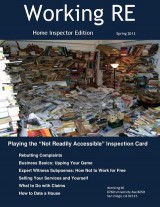
|
Home Inspectors Edition | Circulation 20,000 | Advertise | Subscribe | |
Published by OREP, E&O Insurance Experts | June 2013 |
 Click to Read Current Issue |
>
Click to Print
|
While nearly all home inspectors agree that water heaters are
potentially dangerous appliances, there is a clear disagreement among
them about how and whether to inspect TPR valves.
OREP: Stress-Free E&O Insurance for
Home Inspectors - select your premium, submit with payment and get
back to work in minutes.
What You May Not Know About Water Heater Relief Valves
By Isaac Peck, Associate Editor
“WARNING: FAILURE TO REINSPECT THIS VALVE AS DIRECTED COULD RESULT IN UNSAFE TEMPERATURE OR PRESSURE BUILD-UP WHICH CAN RESULT IN SERIOUS INJURY OR DEATH AND/OR SEVERE PROPERTY DAMAGE.”
This typical Manufacturer’s Warning on a water heater’s temperature
and pressure relief valve (TPR) highlights, in no uncertain terms, the
dangers that a malfunctioning relief valve can pose to both the people
and the property nearby.
Indeed, it’s no secret that water heaters are dangerous.
If the relief valve malfunctions and fails to relieve pressure,
the water heater can explode and launch like a rocket. If you haven’t
seen the damage that an exploding water heater can do, a quick search
on YouTube will yield some spectacular and disastrous examples. While
nearly all home inspectors agree that water heaters are potentially
dangerous appliances, there is a clear disagreement among them about
how and whether to inspect TPR valves.
Case Against Testing
Ken Amelin, an inspector in Mass., doesn’t test the TPR valve mainly
because a lot can go wrong in the testing. “Home inspectors should not
be testing TPR valves. I think it is a very bad idea and a high risk
for liability,” says Amelin.
Amelin explains that a high percentage of TPR valves are faulty and
that when faulty valves are tested by opening or “unseating” them,
they often do not reseat properly and can end up leaking all over the
residence. “Who is responsible for damage or repair if the valve
leaks? If it leaks, YOU [the inspector] OWN IT, and any damage that it
causes. The leaking can continue until the valve is replaced. We
cannot be expected to carry spare TPR valves of various sizes and
shapes to fit all types of heaters. We are not plumbers. Only the
homeowner or licensed plumber should test the device,” says Amelin.
(story continues below)
(story continues)
Amelin says that it’s better for an inspector to recommend that the
valve be tested in the inspection report.
“Inspectors should recommend that the device be tested prior to
purchase and on a regular basis per the manufacturer’s
recommendations. Testing TPR valves should not be within an
inspector’s standard of practice—it is a recipe for disaster,” says
Amelin.
State and Association Standards
Testing a water heater’s relief valve is not required by any of the
major home inspector associations.
For instance, InterNACHI’s Standards of Practice (SOP) state
that the inspector is not required to “test, operate, open or close
safety controls, manual stop valves and/or temperature or
pressure-relief valves.”
However, in some states, home inspectors are required to operate the TPR valve and such testing is actually included in the SOP. For example, in Texas, the SOP for all licensed real estate inspectors requires them to report as deficient any
temperature and pressure relief valve that:
(i) does not operate
manually;
(ii) leaks;
(iii) is damaged;
(iv) cannot be tested due to obstructions;
(v) is corroded; or
(vi) is improperly located
However, the Texas SOP exempts inspectors from operating the TPR valve
“if the operation of the valve may,
in the inspector's reasonable judgment, cause damage to persons or
property.”
Case for Testing
Jerry Peck, a retired inspector who now works as a construction and
litigation consultant, says that he always tested the TPR valve
because it is a safety issue. “It’s imperative for inspectors to test
the valve. We have an obligation to ensure the safety of our clients.”
According to Peck, much of the risk of testing can be avoided if the
inspector knows how to test correctly.
“Operating the relief valve properly is key. If the valve is
stuck, or feels stuck, do not force it open. Write the valve up as
needing to be replaced. The valve is a safety device, and a safety
device should work the first time, every time,” says Peck.
“If you just grab the handle and FORCE it open, then most will probably not reseat (close). But if you get some experience testing the value on newer water heaters, you can get a 'feel' for how they should operate. Then you will be able to 'feel' one that is stuck. If you encounter one, you simply write it up as needing replacement,” Peck says.
In the event that he opens a valve today that
won’t close, Patterson says he has a few steps to minimize leaking.
“If you have a valve that will not seal back completely, if you open
it a few more times and let it wash out, the valve will usually seal
with no drips,” says Patterson.
If the valve still won’t seal, Patterson makes sure the water drains
into a pan. He finishes his inspection and then returns to try to
reseal it. “If I can't get it to seal, I turn the water heater off and
cut the water off at the water heater. I leave a note for the owner
explaining that the valve is leaking and would not reseal, and I try
to call the listing agent so they will know as well,” says Patterson.
Walking the Line
The decision to test a water heater’s TPR valve ultimately depends on
the inspector’s assessment of the risks involved and his or her own
Standards of Practice. For those who do elect to test the valve, the
tips in this article will hopefully save you some headaches. Stay safe
out there!
About the Author
Isaac Peck is the Associate Editor of Working RE Magazine and Marketing
Coordinator at
OREP.org, a leading provider of E&O Insurance for appraisers,
inspectors, and other real estate professionals in 49 states. He received
his Bachelors in Business Management at San Diego State University. He can
be contacted at
Isaac@orep.org or (888) 347-5273.
ATTENTION: You are receiving WRE Online News because you opted in at WorkingRE.com or purchased E&O insurance from OREP. WRE Online News Edition provides news-oriented content twice a month. The content for WRE Special Offer Editions is provided by paid sponsors. If you no longer wish to receive these emails from Working RE, please use the link found at the bottom of this newsletter to be removed from our mailing list.





